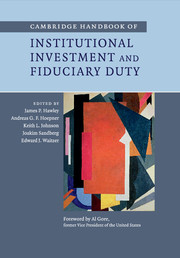Book contents
- Frontmatter
- Contents
- List of figures
- List of tables
- List of contributors
- Foreword
- 1 Introduction
- Part I Fiduciary duty: a global outlook
- Part II Fiduciary duty and the landscape of institutional investment
- Part III Challenging conventional wisdom on fiduciary duty
- 14 Is the search for excessive alpha a breach of fiduciary duty?
- 15 Fiduciary duty and sin stocks:is vice really nice?
- 16 Whose risk counts?
- 17 Sustainability, financial markets and systemic risk
- 18 Uncertain times, plural rationalities and the pension fiduciary
- 19 Emotional finance and the fiduciary responsibility of asset managers
- Part IV Towards a broader interpretation of fiduciary duty
- Part V Beneficiaries’ roles and viewpoints
- Part VI Fiduciary duty and governance
- Index
- References
19 - Emotional finance and the fiduciary responsibility of asset managers
Published online by Cambridge University Press: 05 April 2014
- Frontmatter
- Contents
- List of figures
- List of tables
- List of contributors
- Foreword
- 1 Introduction
- Part I Fiduciary duty: a global outlook
- Part II Fiduciary duty and the landscape of institutional investment
- Part III Challenging conventional wisdom on fiduciary duty
- 14 Is the search for excessive alpha a breach of fiduciary duty?
- 15 Fiduciary duty and sin stocks:is vice really nice?
- 16 Whose risk counts?
- 17 Sustainability, financial markets and systemic risk
- 18 Uncertain times, plural rationalities and the pension fiduciary
- 19 Emotional finance and the fiduciary responsibility of asset managers
- Part IV Towards a broader interpretation of fiduciary duty
- Part V Beneficiaries’ roles and viewpoints
- Part VI Fiduciary duty and governance
- Index
- References
Summary
Introduction
Recent events in the capital markets and the continuing high-profile cases of investment fraud have led to increasing questioning of whether asset managers necessarily act always in the best interests of their clients. A fresh look at the roles of investment professionals and the nature of their investment processes is thus called for. In this chapter, we draw on insights from emotional finance to help us better understand and analyze the behavior of such fiduciaries. Emotional finance is a new area of finance that seeks to understand financial market behavior and investment processes by formally recognizing the role unconscious emotional needs and fantasies play in all investment activity (see, for example, Taffler and Tuckett 2010; Tuckett 2011; Tuckett and Taffler 2012).
All investments have the potential to generate high levels of excitement and anxiety. Using the language of psychoanalysis, investments can become phantastic objects, a term we will carefully define in the next section. Emotional finance helps us better understand how investors in general, and fiduciary investors in particular, can be swayed in their investment decisions by feelings of which they are consciously aware, and specially by those unconscious needs, drives and fears not directly accessible to conscious thought. What does this mean for the clients of investment funds as well as the investment industry more generally? From the perspective of responsible ownership, we argue that all investors, and fiduciaries in particular, have a social, ethical and legal responsibility to explicitly acknowledge the key role emotions, both conscious and unconscious, play in their investment decision-making.
- Type
- Chapter
- Information
- Publisher: Cambridge University PressPrint publication year: 2014

